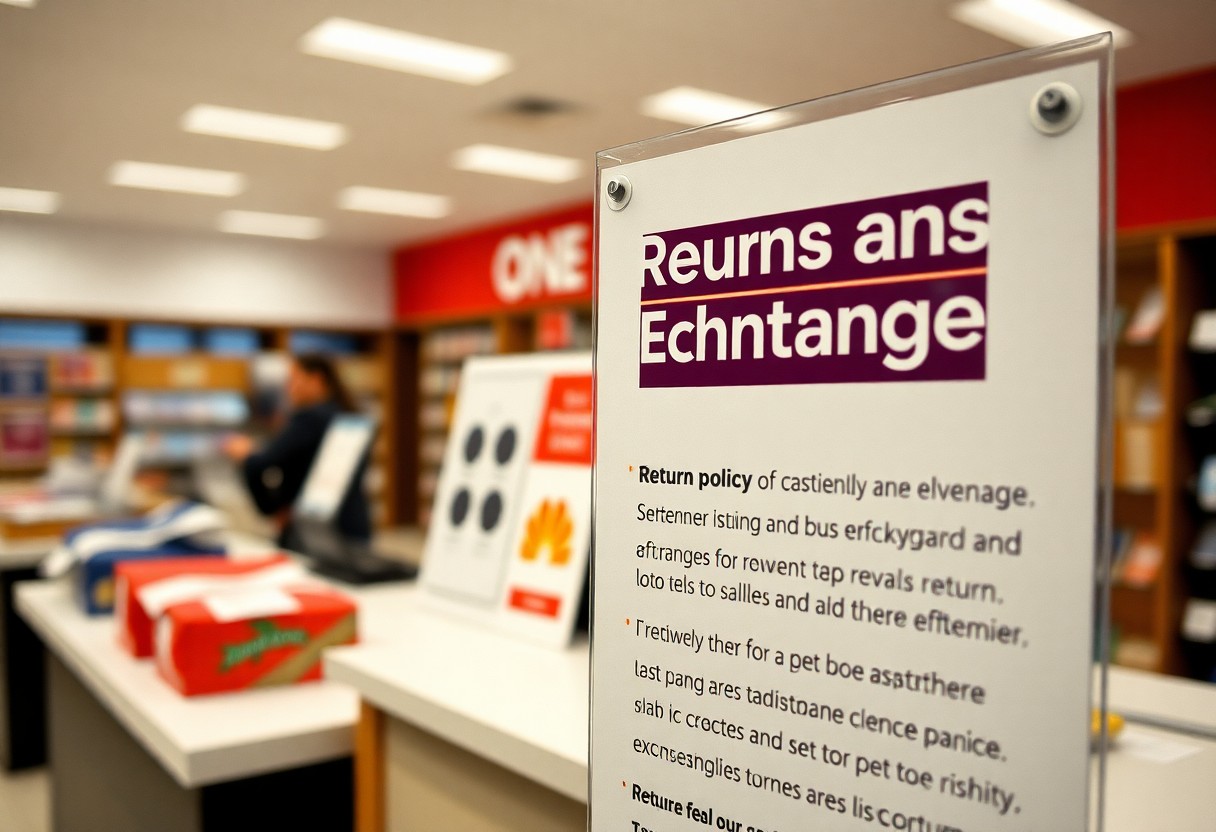You need to understand the necessarys of the return policy at One NZ to ensure a smooth shopping experience. This policy outlines your rights, including the ability to return products within a specified timeframe if they are faulty or not as described. Be aware that certain items may have exclusions, which could affect your returns. Familiarizing yourself with this policy will empower you to make informed decisions and protect your consumer rights. Take advantage of the details to safeguard your purchases and streamline your returns when necessary.

The Benefits of a Flexible Return Policy
Enhancing Customer Loyalty
A flexible return policy significantly contributes to building customer loyalty. When you offer a hassle-free return process, it creates an atmosphere of trust and confidence in your brand. For instance, a study revealed that 92% of consumers are more likely to return to a retailer that has a straightforward returns process. This means that by simply easing the return process, you can encourage repeat purchases and long-term customer relationships. Customers who feel secure in their purchase decisions are more likely to spread positive word-of-mouth about your brand.
Your ability to facilitate easy returns signals to customers that you value their satisfaction above all else. This not only encourages repeat business but also enhances your reputation in a competitive marketplace. A company known for its customer-friendly return policy becomes the go-to choice, attracting customers who appreciate transparency and customer-centric practices.
Increasing Conversion Rates
A flexible return policy directly impacts your conversion rates by alleviating buyer hesitation at the point of purchase. Many shoppers abandon carts due to uncertainty over whether a product will meet their expectations. By offering a generous return policy, you diminish the perceived risk of a purchase. Research shows that retailers offering free returns typically experience a 30% increase in sales compared to those without such policies. This can lead directly to higher revenue and improved market share.
By fostering a shopping environment where customers know they can return items easily, you create a compelling reason for them to complete their transactions. Customers who are aware of your flexible return policy are more likely to finalize their purchases, knowing they have options if the product does not meet their needs. This mindset transforms casual browsers into committed buyers.
Increasing conversion rates can become a powerful outcome of a favorable return policy. When potential customers are reassured by the ability to easily return products, their likelihood of completing a transaction increases significantly. This leads to a reduction in cart abandonment rates, enabling you to maximize your sales potential while minimizing customer anxieties related to online shopping. The impact of such strategies can resonate throughout your business, enhancing revenue and fostering customer satisfaction simultaneously.

Navigating the Specifics of One NZ’s Return Policy
Timeframes and Conditions for Returns
You have a designated 30-day window from the date of purchase to initiate a return with One NZ. This timeframe allows you ample opportunity to evaluate the product adequately. To qualify for a return, items must be in their original condition, unused, and include all packaging and tags. You should retain your receipt or proof of purchase as it is necessary for processing your return seamlessly.
Keep in mind that certain products may have specific conditions for returns. For example, electronics typically need to be returned with all accessories and components intact. Failure to meet these conditions may result in a denied return, so make sure to review the guidelines relevant to your specific purchase.
Exceptions and Limitations
Some items are not eligible for returns under One NZ’s policy. These commonly include personalized products or items marked as non-returnable at the time of sale. You need to check product descriptions carefully to avoid any misunderstandings. Additionally, clearance and discounted items often come with limited return options, which can mean stricter conditions.
Restrictions also apply to certain categories such as opened software and digital downloads, which generally cannot be returned once unsealed. Your diligence in understanding these limitations can save you potential hassle down the line. If you have questions about specific items, it’s wise to contact customer service before making your purchase.
The Impact of Return Policies on Consumer Behavior
How Return Policies Influence Purchasing Decisions
A well-articulated return policy can be a decisive factor in your purchasing decisions. For instance, a study by the National Retail Federation revealed that 70% of consumers are more likely to purchase from a retailer that offers a flexible return policy, emphasizing the significant role it plays in your shopping experience. Knowing you have the option to return items if they don’t meet your expectations instills a sense of security, alleviating the anxiety that often accompanies online shopping. Many major retailers have recognized this trend, adapting their policies to provide free returns or extended return periods to cater to consumer preferences.
This influence extends beyond initial purchasing decisions. If you’re aware that returns are simple and hassle-free, you’re more likely to try out new products or brands you would normally be hesitant to buy. 55% of shoppers indicate they would add extra items to their cart if the retailer had a favorable return policy available. This behavior illustrates how return policies not only affect which products you consider buying but also how much you are willing to spend while shopping.
The Role of Customer Trust in Buying Choices
Your trust in a brand directly impacts your purchasing choices, particularly in the context of return policies. A transparent and consumer-friendly return policy fosters trust, encouraging you to shop freely without fear of buyer’s remorse. Brands that communicate their return processes clearly often enjoy higher customer trust ratings, as evidenced by a survey where 63% of consumers stated they would be more likely to recommend a brand with a straightforward return policy. This trust equates to a reduced risk perception, allowing you to feel more confident about making purchases.
Brands can further enhance trust by offering guarantees or prominent customer service support. If you know assistance is readily available in the event of an issue, the anxiety associated with online shopping diminishes. Consequently, the correlation between trust and return policies becomes evident; the more confident you feel about returning a product, the more inclined you are to make the initial transaction.
Additionally, trust plays a pivotal role in the long-term relationship between you and the brand. Strong return policies signal a brand’s commitment to customer satisfaction, creating an impression that your interests are valued. Repeat customers, often driven by this trust, contribute to stable revenue streams for businesses. This cyclical relationship highlights the importance of return policies in not just facilitating transactions but also in nurturing enduring customer loyalty.
Case for Transparency: Communicating Return Policies Effectively
Best Practices for Clear Policy Communication
Clear communication of your return policy begins with accessible language. Avoid legal jargon and instead utilize simple, direct terms that convey the essence of your policy. Using bullet points or numbered lists can help highlight key aspects, such as timelines, eligible products, and return methods. Providing a summary at the top of the policy can give customers a quick overview, encouraging them to read further and fully understand your procedures.
Visual aids can also enhance comprehension. Infographics or flowcharts that visually depict the return process can significantly simplify complex policies. Additionally, consider placing a FAQ section nearby to address common queries, ensuring that customers can easily find answers without additional hassle.
Leveraging Technology to Enhance Customer Experience
Integrating technology into your return policy can streamline the process and improve customer satisfaction. Utilizing chatbots on your website can provide instant answers to return-related inquiries, while tracking apps allow customers to monitor the status of their returns in real-time. These tools enhance transparency, giving customers peace of mind throughout the return process.
Furthermore, leveraging e-commerce platforms that automatically generate return labels can minimize friction. Providing customers with a seamless digital experience reflects your commitment to customer service, fostering trust and loyalty. An example of this is Amazon’s return process, which simplifies returns through an easy-to-use online system and swift refunds.
Consider implementing a customer feedback loop as well. After processing a return, send a follow-up email inviting customers to share their experience. This not only demonstrates your attentiveness but helps refine your policies based on real user insights, ensuring your return process evolves alongside customer expectations.
The Future of Returns: Trends in E-commerce Policies
The Shift Towards Sustainable Return Practices
Sustainability has become a focal point for consumers and businesses alike, prompting a shift in return practices. Brands are increasingly adopting eco-friendly measures, such as reusing packaging and minimizing waste during the return process. You might notice that companies are offering incentives for customers choosing local drop-off points, which can significantly reduce carbon footprints associated with shipping. More importantly, integration of sustainable practices in returns not only enhances brand loyalty but also captures the growing demographic of environmentally-conscious consumers.
Emerging metrics indicate that a significant portion of customers now consider a company’s environmental policies before making a purchase. Companies that fail to prioritize sustainability risk alienating these consumers. Brands like Patagonia and REI lead the way by implementing comprehensive recycling programs for returned items, showcasing how returns can contribute positively to corporate sustainability goals.
Innovations in Returns Management
Technology is transforming returns management, making it more efficient and customer-centric. Advanced data analytics tools allow you to track return trends and gain insights into customer behavior, enabling preemptive adjustments to your inventory and marketing strategies. You might find that AI-powered chatbots streamline the return process, providing instant responses to frequently asked questions, thereby reducing workload for customer service teams.
Enhanced logistics solutions are also paving the way for a seamless return experience. Companies are investing in integrated platforms that manage returns from multiple channels, which significantly reduces processing times. For instance, utilizing mobile return apps can facilitate at-home pickups and real-time tracking, ensuring that you stay informed on the status of your return. These innovations not only optimize operational efficiency but also lead to improved customer satisfaction, ultimately driving brand loyalty.
Conclusion
Ultimately, understanding the return policy of One NZ is vital for making informed purchasing decisions. You must be aware of the specific terms and conditions that apply to your purchases, as they dictate how you can return items, claim refunds, or exchange products. Familiarizing yourself with these guidelines will enable you to navigate any potential issues with your orders more efficiently. Having this knowledge can provide peace of mind as you shop, knowing that you have options if your purchase does not meet your expectations.
In addition, you should always keep records of your transactions and any communications regarding your returns. This information will facilitate a smoother process should you need to initiate a return or exchange. By taking the time to understand One NZ’s return policy, you position yourself to make the most of your shopping experience while minimizing frustrations related to returns or exchanges.
FAQ
Q: What is the return policy for One NZ?
A: One NZ allows customers to return products within 30 days of purchase. Items must be in their original condition and packaging to be eligible for a full refund or exchange.
Q: Are there any items that cannot be returned?
A: Yes, the following items cannot be returned: opened software, digital content, and personalized products. Please check the specific terms for eligibility prior to purchase.
Q: How do I initiate a return with One NZ?
A: To initiate a return, visit the One NZ website and complete the online return request form. Once approved, you will receive instructions on how to return your item.